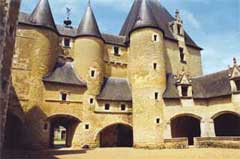English Castle
The English castle of the Medieval period is mainly a result of the Norman invasion. There were some strong places before the arrival of William the Conqueror, but they were very few. Violet le Duc says that the Normans were the first people in Western Europe to build castles, not as isolated fortresses, but as a scheme of general defense, developed as a result of a political idea affecting their geographical distribution, and even their individual planning and arrangement.

English Castle: Warwick
The English castle was a prominent presence in almost all of the large towns. It played an essential role in the defence of the country. The river valleys, the main channels of traffic, the important fords and bridges ended up being guarded by castles. On the coast, particularly in the south-east, the part most susceptible of invasion, all convenient landing places were similarly protected.
These castles kept open the main lines of communications across country, while in the dangerous districts each large estate possessed a castle primarily built for the protection of the tenant, but also being part of the general defense of the neighborhood. Such castles were especially numerous on the Scottish border and in the Welsh Marches.
Development of the English CastleStarting with the Norman castle, three main factors governed the subsequent evolution of castles:
- The growth of luxury and the increasing idea of comfort.
- The gradual improvement in methods of attack.
- The introduction, through influence of returning crusaders, of the more scientific military architecture of the Byzantine Empire.
The first of these led the inhabitants of the castles to renounce using the keep as a place of residence; always cold, inconvenient, and uncomfortable, its cramped accommodation became too limited for the growing numbers of dependants in personal service.
Of at least equal importance in the development of the castles was the improvement in the art of siege. All through the Medieval period the art of defense was always in front of that of attack, and even the gunpowder did not, for a long time, alter the relation.
The architecture of the Medieval castles changed as a result of the Crusades. The soldiers of Western Europe became acquainted with the more advanced art of fortification of the Byzantine Empire, and the fortifications concept of an outer and inner ward.
This led to the development of the concentric castles (or Edwardian castles). The main ward was girt with a high wall, strengthened by a circle of projecting mural towers, so placed that no attacking party could approach the base of the wall without being exposed to an overwhelming fire from them, and further all subordinated wards were so completely dominated by the high wall of the inner ward that even if taken they could not be held against it.

Leeds Castle
During the long reign of Edward III, a radical change took place in the development of the English castle. The need for fortress-castles ceased, and few new ones were built, except on the Scottish border. Later then Edward’s reign scarcely a single defensible castle was founded, and many of the existing royal castles fell into disrepair, or were handed over to their counties to be used as jails.
The place of the fortress-type Medieval castles was taken by the castle-palace, quadrangular groups of buildings around a central courtyard, adorned rather then protected by angle towers, gatehouse and moat. A marvellous example is Leeds Castle.
The English castle of this period lacked the strong defensive character of previous times. There was some attempt at defensibility, made by increasing the thickness of the outer walls and the absence of any important external openings, but overall, the majority of the castles had large external windows and walls of no great strength.

